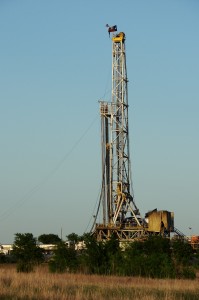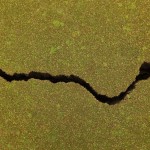What You Need to Know About Earthquakes and Fracking

This rig uses hydraulic fracturing to obtain gas from Texas' Barnett Shale formation. Photo courtesy of KUT News.
After a 4.0 earthquake struck Youngstown, Ohio Saturday, some people were scratching their heads and asking, did hydraulic fracturing (aka “fracking”) cause this? After all, it was the eleventh quake since March, and the most intense. On top of that, all of the quakes have been centered around a deep well used to dispose of hydraulic fracturing fluid used to drill for natural gas.
A few days have passed, and we now have some more answers about the quake and how it is related to drilling. The disposal wells in Ohio are similar to ones used in Texas, where we had our own 4.8 magnitude earthquake near drilling and disposal sites in the Eagle Ford Shale in October. The seismic activity in Texas, Ohio and elsewhere may indicate a link between fracking fluid disposal wells and earthquakes.
Over at NPR, Science Correspondent Christopher Joyce has a thorough explainer on what happened in the Ohio earthquake:
“Hydraulic fracturing pumps a lot of water underground, where it’s used to crack the rock and liberate gas. This may cause tiny quakes, but fracking goes on for a day or two, and the quakes are small.
Recent quakes reported in Ohio and Arkansas are associated with wastewater wells, not fracking wells. The water first used in fracturing rock is retrieved and pumped into these waste wells, which take in lots of water. And at more than 9,000 feet deep, the water is under high pressure that can build up over months or years. It’s this pressure that can actually create earthquakes.”
Joyce (and some others) have noted that a 4.8 quake in the 1960s in Colorado was linked to a disposal well, and while these “induced” quakes are “rare and usually small, but now fracking is creating thousands of wastewater wells, often in heavily populated areas that historically have not been seismically active.” When wells are all around, even small quakes have a big effect.
NPR also spoke with seismologist John Armbruster, who makes a definitive link between the disposal wells and the quake:
“Well, we look at the evidence. Youngstown is an area which doesn’t have a history of earthquakes. This disposal well started operating in December of 2010. Three months later, the earthquakes began and the earthquakes are trickling along. From March to November, you have nine earthquakes, all of a similar size, 2.5, 2.1, 2.7.
On Christmas Eve, there was a magnitude 2.7 earthquake. Our location of that Christmas Eve earthquake was about one kilometer from the bottom of the well and the location of the earthquake was sufficient evidence that there could be a link.”
In the Wall Street Journal, Daniel Gilbert points out how Ohio has become a dumping ground for Pennsylvania’s drilling waste:
“Ohio last year permitted the most such wells since 1988, and 2011 also marked the first year that a majority of the waste injected underground in the state came from out of state, notably from Pennsylvania, which is in the midst of a drilling boom, Ohio officials say.
Pennsylvania doesn’t prohibit injection wells, but officials there say the state has limited geologic formations that are suitable for them. Pennsylvania has seven wells that can receive waste; Ohio has permitted 194.”
The Associated Press talked to Ohio politicians about why the state has suspended the disposal well believed to have caused the quake:
“Drilling’s very important for our economy and to help us progress as a state, but every single person in the Mahoning Valley felt this earthquake,” said state Sen. Joe Schiavoni, a Youngstown Democrat who on Tuesday called for a public hearing.
“I wouldn’t deem it as an emergency, but when you live in a place that you’re not used to earthquakes and you have 11 earthquakes, you’re concerned,” he said. “We need to give them some sort of confidence or security that this is going to be OK.”
Today comes word from the Columbus Dispatch that the state is going to let the fracking fluids in the disposal wells come back up to the surface. They hope this will relieve pressure on the wells and hopefully alleviate the earthquakes:
“State officials say they will let waste fluids that were injected thousands of feet down a Youngstown disposal well bubble back to the surface in an effort to relieve underground pressure that might have caused a series of earthquakes.
The original injection pressure should force the brine back out of the well into 12 storage tanks, said Andy Ware, a deputy director of the Ohio Department of Natural Resources, which oversees Ohio’s oil and gas industry. The hope is that will help stop the ground from shaking.”
A big question in all of this: Can you dispose of fracking fluid without causing earthquakes? Reuters says the answer is yes, but with a high price:
“It costs about $10 million a pop. A thorough seismic survey to assess tracts of rock below where oil and gas drilling fluid is disposed of could help detect quake prone areas.
But that would be far more costly than the traditional method of drilling a bore hole, which takes a limited sample of a rock formation but gives no hint of faults lines or plates.”



